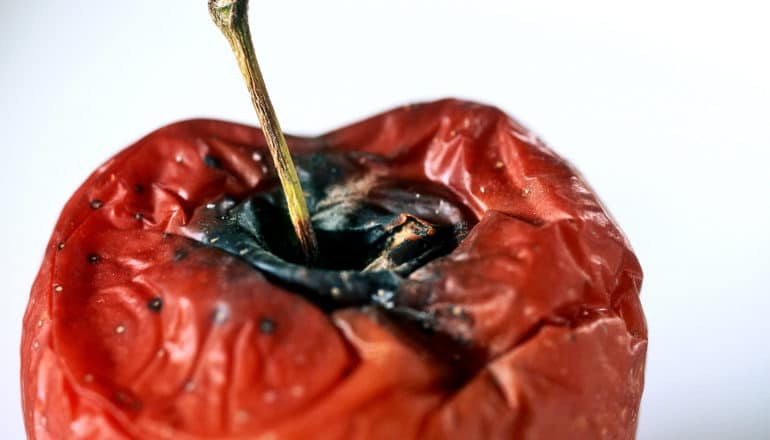
People consider mold-prone food more natural—and therefore better—than those with long shelf lives, according to a new study.
The researchers think, however, that belief may change in the wake of COVID-19.
Is an oozing apple with fuzzy white mold better than one that is fresh and green a month after you bought it? Yes, according to the new study of perceptions of food “purity” and “impurity.”
“We associate purity with what’s natural. That means that much of what was once considered impure, such as soil, mold, bacteria, and dust, is now seen as pure, when contrasted with a pesticide sprayed and preservative coated apple that never perishes,” says Kia Ditlevsen, associate professor in the food and resource economics department at the University of Copenhagen.
For their paper in Sociology researchers analyzed two qualitative studies that included interviews with 69 Danes, in which the discussion focused on ecology, local foods, and dietary supplements.
The conclusion is clear: respondents preferred the natural and had suspicions about foods treated to guarantee lengthy shelf lives.
Food purity vs. impurity
The researchers report a shift in attitudes about what characterizes “clean” foods over the past 40-50 years.
In the past, food safety concerns were more widespread. Consequently, there was a perception that the greater the sterility, the better the quality. The presence of soil was completely unthinkable in the understanding of “clean” foods, as many people feared bacteria and microorganisms at the time.
“Today, our concepts of food purity have changed. What is objectively referred to as dirty, i.e. mold, etc., is less frightening to us than apples which never rot. Similarly, having dirt under one’s nails has become a sign of health,” Ditlevsen, says.
To illustrate the trend, she refers to a Burger King advertisement from February 2020. “For many people, Burger King is associated with products that may not be quite all-natural—but do last a long time. To shift this perception, the fast food chain released large advertising banners with a picture of a moldy Whopper, their signature burger.”
Thus, the use of ingredients without unnecessary preservatives has become a branding strategy. In other words, we are wild about the naturalness and visibility of what a product contains.
“However, this should not be confused with not caring about whether or not our food has mold on it. Food safety remains extremely important, but we nearly take it granted here in Denmark, despite the problems that regularly arise.
“The focus on naturalness that we found is that some consumers are concerned about modern food production methods. For example, they are uncertain about the impact of pesticides and chemistry upon us,” Ditlevsen says.
Will mold take a back seat to sterility?
Several of the study’s respondents said they find the artificial sweeteners and dyes used in, for example, Coca-Cola Light, both disgusting and unnatural.
“We seek to cleanse our bodies of harmful chemistry. A growing number of people believe that this can be achieved by opting for foods that are perceived as pure and natural. Among other choices, this might include the purchasing of organics,” says Ditlevsen.
But, conceptions of “pure” and natural products will likely evolve over time, along with the events going on, such as the coronavirus pandemic, she says.
“Many people are concerned about climate, nature, environment, and food production in this regard. That’s why naturalness has become important for so many. On the other hand, the coronavirus pandemic has intensified our focus on hygiene and sterility, in terms of disinfecting, distancing, etc.,” says Ditlevsen.
“Perhaps sterility and control will once again become the focus of consumers with regards to food. But it may also be that the current trend continues—only time will tell.”
Source: University of Copenhagen
The post Mold-prone food seems more natural and ‘pure’ appeared first on Futurity.
from Futurity https://ift.tt/2H1kyaH
No comments:
Post a Comment